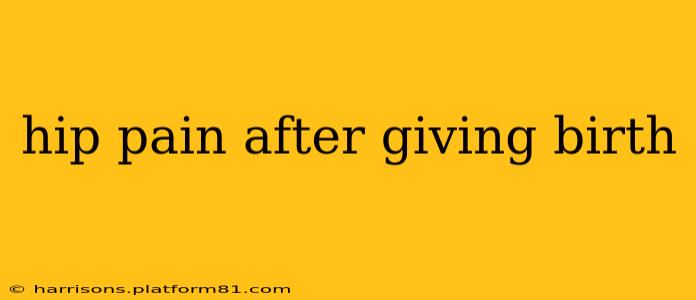Pregnancy and childbirth put immense strain on a woman's body, and hip pain is a surprisingly common complaint in the postpartum period. The hormonal changes, weight gain, and physical demands of carrying a baby and then delivering it can all contribute to discomfort and pain in the hip region. Understanding the causes, seeking appropriate treatment, and focusing on recovery are crucial for new mothers.
This comprehensive guide will delve into the various reasons why new mothers experience hip pain, explore effective treatment options, and provide valuable advice for managing and recovering from this often debilitating condition.
What Causes Hip Pain After Childbirth?
Several factors can contribute to hip pain after giving birth. These include:
-
Relaxin Hormone: During pregnancy, the body produces high levels of relaxin, a hormone that softens ligaments and joints in preparation for childbirth. While beneficial for delivery, this hormonal surge can also lead to instability in the hip joints, making them more susceptible to pain and injury.
-
Weight Gain: The weight gain associated with pregnancy puts extra stress on the hips, exacerbating any pre-existing conditions or weaknesses. This increased weight can strain the joints and surrounding muscles, resulting in pain and discomfort.
-
Postural Changes: The shifting center of gravity during pregnancy often leads to postural changes that can strain the hip muscles and joints. This can contribute to pain and discomfort, especially as the pregnancy progresses.
-
Pelvic Instability: Pregnancy can cause instability in the pelvic joints, leading to pain that radiates into the hips. This instability can be exacerbated by the delivery process itself.
-
Muscle Weakness: Pregnancy and childbirth can weaken the muscles that support the hips and pelvis. This weakness makes the joints more vulnerable to injury and pain.
-
Symphysis Pubis Dysfunction (SPD): This condition involves pain and instability in the joint connecting the two pubic bones. While SPD is often experienced during pregnancy, it can persist or worsen after childbirth.
-
Sacroiliac (SI) Joint Dysfunction: The SI joint connects the sacrum (the triangular bone at the base of the spine) to the pelvis. This joint can become inflamed or unstable during pregnancy and after delivery, resulting in hip and lower back pain.
How Long Does Postpartum Hip Pain Last?
The duration of postpartum hip pain varies greatly depending on the underlying cause and the individual's response to treatment. For some, the pain may subside within a few weeks, while others may experience persistent discomfort for several months or even longer. Early intervention and appropriate treatment are key to minimizing the duration of the pain.
What Treatments Are Available for Postpartum Hip Pain?
Treatment for postpartum hip pain depends on the cause and severity of the pain. Common approaches include:
-
Physical Therapy: Physical therapy plays a crucial role in strengthening the muscles supporting the hips and pelvis, improving joint stability, and restoring proper posture. Exercises often focus on core strengthening, pelvic floor exercises, and gentle stretches to improve flexibility and reduce pain.
-
Rest and Ice: Resting the affected hip and applying ice packs can help reduce inflammation and alleviate pain.
-
Pain Medication: Over-the-counter pain relievers such as ibuprofen or acetaminophen can help manage pain and inflammation. In some cases, a doctor may prescribe stronger medication.
-
Manual Therapy: Techniques like chiropractic care or osteopathic manipulation can help realign the pelvis and reduce joint restrictions.
-
Support Belts or Braces: These can help stabilize the pelvic joints and reduce pain.
Can Exercise Help with Postpartum Hip Pain?
Yes, specific exercises can be very beneficial in managing and alleviating postpartum hip pain. However, it's crucial to consult with a physical therapist or healthcare professional before starting any exercise program. They can design a personalized plan that addresses your specific needs and avoids further injury. Exercises often include:
-
Pelvic floor exercises (Kegels): Strengthening the pelvic floor muscles can improve pelvic stability and reduce pain.
-
Hip strengthening exercises: These exercises focus on strengthening the muscles surrounding the hip joint, improving stability and reducing strain.
-
Gentle stretching exercises: Stretching can improve flexibility and reduce muscle tension, which can contribute to hip pain.
-
Low-impact cardio: Activities such as walking or swimming can help improve circulation and overall fitness without putting excessive stress on the hips.
When Should I See a Doctor About Postpartum Hip Pain?
You should seek medical attention if your hip pain is severe, persistent, or accompanied by other symptoms such as numbness, tingling, or weakness in your leg. It's also important to consult a doctor if your pain doesn't improve with self-care measures or if you suspect a more serious underlying condition.
What Can I Do to Prevent Postpartum Hip Pain?
While some factors contributing to postpartum hip pain are unavoidable, there are steps you can take to mitigate the risk:
-
Maintain a healthy weight throughout pregnancy: Avoid excessive weight gain to reduce stress on your hips and joints.
-
Engage in regular, moderate exercise during pregnancy: Strengthening your core and hip muscles can help support your joints and reduce the risk of pain. Consult your healthcare provider for suitable exercises.
-
Practice good posture: Maintaining good posture during pregnancy can help prevent strain on your hips and back.
-
Seek professional guidance: Consult with a physical therapist or other healthcare professional for advice on exercise, posture, and other strategies to reduce your risk of hip pain.
By understanding the causes of postpartum hip pain, seeking appropriate treatment, and focusing on recovery, new mothers can effectively manage their pain and return to a comfortable and active lifestyle. Remember, seeking professional guidance is essential for a personalized approach to recovery.
